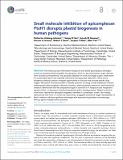| dc.contributor.author | Amberg-Johnson, Katherine | |
| dc.contributor.author | Ganesan, Suresh M. | |
| dc.contributor.author | Lorenzi, Hernan A. | |
| dc.contributor.author | Niles, Jacquin C. | |
| dc.contributor.author | Yeh, Ellen | |
| dc.contributor.author | Hari, Sanjay B. | |
| dc.contributor.author | Sauer, Robert T. | |
| dc.date.accessioned | 2018-02-09T17:16:50Z | |
| dc.date.available | 2018-02-09T17:16:50Z | |
| dc.date.issued | 2017-08 | |
| dc.date.submitted | 2017-06 | |
| dc.identifier.issn | 2050-084X | |
| dc.identifier.uri | http://hdl.handle.net/1721.1/113561 | |
| dc.description.abstract | The malaria parasite Plasmodium falciparum and related apicomplexan pathogens contain an essential plastid organelle, the apicoplast, which is a key anti-parasitic target. Derived from secondary endosymbiosis, the apicoplast depends on novel, but largely cryptic, mechanisms for protein/lipid import and organelle inheritance during parasite replication. These critical biogenesis pathways present untapped opportunities to discover new parasite-specific drug targets. We used an innovative screen to identify actinonin as having a novel mechanism-of-action inhibiting apicoplast biogenesis. Resistant mutation, chemical-genetic interaction, and biochemical inhibition demonstrate that the unexpected target of actinonin in P. falciparum and Toxoplasma gondii is FtsH1, a homolog of a bacterial membrane AAA+ metalloprotease. PfFtsH1 is the first novel factor required for apicoplast biogenesis identified in a phenotypic screen. Our findings demonstrate that FtsH1 is a novel and, importantly, druggable antimalarial target. Development of FtsH1 inhibitors will have significant advantages with improved drug kinetics and multistage efficacy against multiple human parasites. | en_US |
| dc.description.sponsorship | National Institutes of Health (U.S.) (Award AI016892) | en_US |
| dc.description.sponsorship | National Institutes of Health (U.S.) (Award F32GM116241) | en_US |
| dc.publisher | eLife Sciences Publications, Ltd | en_US |
| dc.relation.isversionof | http://dx.doi.org/10.7554/ELIFE.29865 | en_US |
| dc.rights | Creative Commons Attribution 4.0 International License | en_US |
| dc.rights.uri | https://creativecommons.org/licenses/by/4.0/ | en_US |
| dc.source | eLife | en_US |
| dc.title | Small molecule inhibition of apicomplexan FtsH1 disrupts plastid biogenesis in human pathogens | en_US |
| dc.type | Article | en_US |
| dc.identifier.citation | Amberg-Johnson,et al. “Small Molecule Inhibition of Apicomplexan FtsH1 Disrupts Plastid Biogenesis in Human Pathogens.” eLife 2017, 6 (August 2017): e29865 © Amberg-Johnson et al | en_US |
| dc.contributor.department | Massachusetts Institute of Technology. Department of Biological Engineering | en_US |
| dc.contributor.department | Massachusetts Institute of Technology. Department of Biology | en_US |
| dc.contributor.mitauthor | Hari, Sanjay B. | |
| dc.contributor.mitauthor | Sauer, Robert T. | |
| dc.relation.journal | eLife | en_US |
| dc.eprint.version | Final published version | en_US |
| dc.type.uri | http://purl.org/eprint/type/JournalArticle | en_US |
| eprint.status | http://purl.org/eprint/status/PeerReviewed | en_US |
| dc.date.updated | 2018-02-02T19:08:02Z | |
| dspace.orderedauthors | Amberg-Johnson, Katherine; Hari, Sanjay B; Ganesan, Suresh M; Lorenzi, Hernan A; Sauer, Robert T; Niles, Jacquin C; Yeh, Ellen | en_US |
| dspace.embargo.terms | N | en_US |
| dc.identifier.orcid | https://orcid.org/0000-0003-0606-9896 | |
| dc.identifier.orcid | https://orcid.org/0000-0002-1719-5399 | |
| dspace.mitauthor.error | true | |
| mit.license | PUBLISHER_POLICY | en_US |
